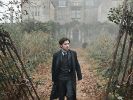Eye For Film >> Movies >> The Woman In Black (2012) Film Review

Edwardian solicitor Arthur Kipps (Daniel Radcliffe) is sent from London to a Norfolk hamlet to sort out the papers of a recently deceased old lady. Alice Drablow lived alone in the darkly imposing Eel Marsh House, cut off from the rest of the world twice a day when tides cover the causeway leading to it. Bentley, the local agent retained by Arthur's employer, tries to force him to leave the very day he arrives, with only a tiny packet of papers representing Mrs Drablow's legal effects. Arthur, though, is determined to carry out his assignment, partly because he'll lose his job if he doesn't - four years of widowhood have seen his star fall at the firm.
At the house, eerie things happen, the most unsettling of which is the appearance of a silent figure in the private graveyard, a pale, wasted woman in black. Back at the village, no sooner does Arthur tell a rattled policeman of the strange woman, than a local child dies ...

And so on. I won't give out any more story details; suffice to say, if you're a fan of spinechillers at all, this is a film to see. You may think you know everything that will happen on screen, but you don't.
And besides, a good story can survive many tellings. The Woman In Black began as a novel by Susan Hill, was adapted into a stage play and then became a television film. I've not read the novel, but the TV version gave me nightmares, and I always make sure to catch the stage play, in which the story is inventively reworked for just two actors (and perhaps the odd spectral presence).
This version is its own beast, adding new bits of business while expanding on existing strands. The slow-building tension of the stage play is still there, but the added narrative space sees room for for Grand Guignol shocks aplenty. Happily, these work too - at my screening audience members gasped and screamed with delightful regularity, and there's one new moment that gives me chills just thinking about it as I type.
At the centre of the action is Radcliffe, in his first screen role since the Harry Potter series ended. Even with stubble, he's too fresh faced to be an obvious choice to play a widower with a four-year-old son. Within a few minutes, though, the complaint vanishes like ectoplasm; this isn't a movie that wastes time getting into the story, it speeds along like an out-of-control ghost train. Indeed, the opening scene featuring three young sisters is a beautifully judged vignette that chills the heart. By the time Kipps is meeting kindly rich gent Sam Daily (Ciaran Hinds) en route to the village of Crythin Gifford, you'll likely have stopped wondering just when young Potter actually started shaving, eager to see what comes next.
While it's not fair to say Radcliffe is called upon to carry the film - as well as Hinds, notable thesps include the great Janet McTeer as Mrs Daily, and Roger Allam as Bentley - he's alone on screen a lot of the time. And he holds the attention with an intelligent performance suggesting that this is a man with ghosts of his own. That's where one of my few complaints about the film comes in: we know Kipps is a widower and Radcliffe amply conveys that he's still in love with his wife.
He's entirely plausible as a man who, understandably, wishes to believe in an afterlife, while facing the very sane urge to run as spirits surround him - we don't need the occasional dreamy shots of the late Mrs Kipps flouncing around in a bridal dress-cum-shroud, the Woman in White, to 'explain' his mental state.
The other big stars are the cinematography of Tim Maurice-Jones and the production design of Kave Quinn - Eel Marsh House is as much a terrifying presence as the titular spook, and unlike her, it never recedes into the darkness; it is the darkness.
As one of the new breed of Hammer Films, The Woman In Black does its British forebears proud, thanks in large part to director James Watkins and writer Jane Goldman, who translate Hill's elegant tale into cinematic gold. Watkins elicits believable reactions from his performers and creates a brooding atmosphere of menace. While wrangling a few extra ghosts, he never allows the story to descend into a Disney fun park ride. And a couple of early, ugly verbal contractions apart, Goldman has the characters sounding as we'd expect, while building the story to a crescendo.
Ignore the 12A certificate - The Woman In Black was originally given a 15 by the British Board of Film Classification, but was toned down only slightly (sound levels were tweaked and shades were made shadier) to allow a wider audience to see it. Do not assume this is a good half-term outing for pre-teen Potteristas.
I've heard comparisons with Robert Wise's 1963 classic The Haunting but that film gains its scares from claustrophobic camera angles and a clever soundscape - no ghost ever appears on screen. While The Woman In Black also uses sound effectively, it does so in a less subtle way and isn't shy of showing its revenants. And its sharply defined characters are all-important to The Haunting, whereas the new film really only asks us to care about Kipps. That's not to say either film outclasses the other, merely that despite superficial similarities, they're different animals. Decades after seeing The Haunting for the first time, thinking of it still fills my spine with shivers. It's mere days since I saw The Woman in Black, and I'm still getting scared remembering certain moments. I suspect these will stay with me too.
Reviewed on: 13 Feb 2012


















